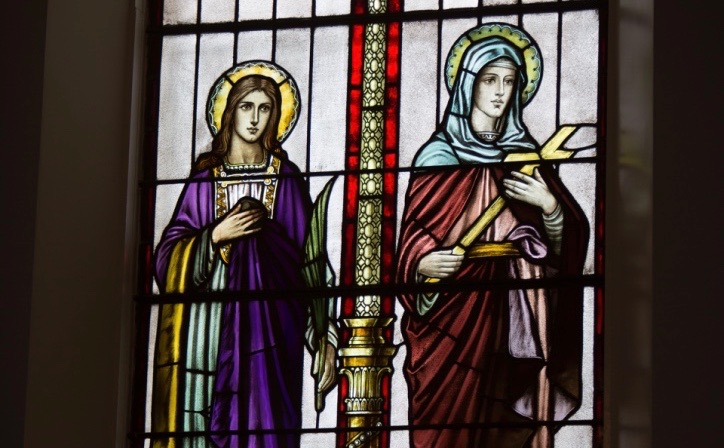
by Kathy and Mitch Finley
We have yet to find anyone, adult or child, who is not bowled over when they hear the story of St. Maximilian Kolbe. In a World War II Nazi death camp, Franciscan Father Kolbe volunteered to take the place of another man who was selected to die.
Who can fail to be impressed by the story of St. Elizabeth Ann Seton, the first native-born citizen of the United States to be canonized a saint? She established the first Catholic school in the nation, and she founded the first American congregation of religious sisters: the Sisters of Charity.
The Inspiration of the Saints
We belong not only to a worldwide Church but also to a Church that transcends time and space. We participate in the life of a worldwide community of faith, and we participate in a community of faith that extends through time. All this is called the Communion of Saints. The saints are people of deep faith who lived before us, in years past and centuries past, but they are really and truly alive to us here and now, too.
Our students need to know that, just as we pray for one another as we make our way through life, we can ask the saints to pray for us as well. We can gather inspiration from the stories of the saints’ lives. Here are some practical ways we can do this:
Display art and photographs that depict saints of all sorts. This need not be an expensive project. There are many ordinary holy cards depicting images of saints available from Catholic religious-goods stores or from online sources. In your classroom, you can easily display pictures of saints’ images, and you can encourage parents to do likewise in the home. Holy cards are readily available, and images are easy to locate and print from online sources.
When opportunities arise, talk with children about your own experiences with the saints. For example, perhaps you lost something and asked St. Anthony’s help in finding it. You can easily talk about St. Jude, the patron saint of hopeless causes. If you don’t have a personal story to tell about a particular saint, share things you have read or heard about the intercession of a saint.
Read aloud stories from the lives of the saints. This is effective even with preschoolers. It’s the rare child who doesn’t enjoy being read aloud to, and it shouldn’t be difficult for any lesson plan to include time to read aloud from the lives of the saints. Encourage parents to take advantage of storybooks about saints to use as bedtime reading. As kids get older, they can comprehend biographies of saints written for grownups.
Include the saints in your lesson plans. Keep a Catholic calendar handy. As you make up each lesson plan, look for opportunities to tell stories from the lives of saints. For example, when discussing Sacraments, be on the lookout for saints who had a particular devotion to particular Sacraments. Saint Pius X encouraged early and frequent reception of Holy Communion. Saint John Vianney was a great promoter of the Sacrament of Penance and Reconciliation.
If you see a saint’s name that you don’t recognize or about whom you don’t know much, ask a student to research that saint and report on him or her at the next class. Consider, for example, Blessed Pier Giorgio Frassati. He is the patron of young adults, and many a young person will be excited and inspired by what they learn about him.
On the feast day of your favorite saint, share with your students why you like that saint, talk about praying for the saint’s intercession, and do a little catechesis on how we pray to saints to ask them to pray for us. (We do not pray to saints because we think they will do something for us that God or Jesus can’t or won’t do.) The saints are our friends and, just as we pray for our earthly friends and they pray for us, our friends in heaven are happy to pray for us.
Encourage each student to nourish an awareness of and a relationship with his or her patron saint. When the feast day of a student’s patron saint is coming up, remark about that and wish the child a happy “name day.” Explain the concept of “patron saint.” Explain to students that they can pray to their patron saints, asking for the saints’ prayers in both everyday and special situations.
See if your parish library has a good supply of books and videos about saints, and encourage your students to check these out and take them home. Encourage parents to keep books and other resources about the saints in readily accessible places in the home: on bookshelves or on table tops. You and your students’ parents may have old books about the lives of the saints from childhood; share these with the kids. Youngsters are sometimes intrigued by a book they know a parent or a teacher read when he or she was growing up. Encourage parents, grandparents, and godparents to include books and/or other resources about saints among the gifts they give.
Give devotion to Mary a special place in your classroom. Sometimes we overlook the fact that Mary the mother of Jesus is, first of all, a saint. Schools, hospitals, parishes, and so forth are often named for St. Mary. Among all the saints, Mary has a special place of honor among Catholic devotions. Along with teaching children to pray the Hail Mary, give a place of special honor in your classroom to a picture or statue of the Blessed Mother.
Help your students learn to pray the Rosary, and let them know that you yourself have a special affection for Mary. Help them learn traditional prayers such as the Memorare and the Hail, Holy Queen. You can do this by including one of these prayers at the beginning of each class. During May (the month dedicated to Mary) and October (the month dedicated to the Rosary), make it a point to include in your classes information and stories about the Blessed Mother.
Our Happy Companions
A synonym for holy is hale and hearty. Catholic kids have access to a religious subculture that includes thousands of holy (hale and hearty of faith) men and women. We do our children a grave disservice if we fail to introduce them to these heavenly people who are happy to be our companions on our earthly pilgrimages. So make it a point to include the saints in your catechetical efforts as often as you can.
For Catechists to Consider
1. Learn each student’s patron saint and feast day, and celebrate those feast days during your class sessions. If a child’s feast day does not occur during the school year, arrange for an honorary feast day. Always mention one “fun fact” about each patron saint which the child can take home to share.
2. Acknowledge non-Catholic and/or non-canonized heroes of faith when they come up throughout the year or in the news—such as Martin Luther King Jr. or Dorothy Day.
3. Who is your favorite saint and why?
For Parents to Consider
1. Give each child a name-day celebration; this need not be elaborate. On that day, give the child a holy card with his or her patron saint’s image on it and maybe a special treat.
2. Honor Mary the mother of Jesus on days when her various feasts occur. Cultivate a healthy appreciation for praying the Rosary in your home.
3. Read aloud to your children stories from the lives of the saints, and keep books and videos about saints in easily accessible places.
Kathy and Mitch Finley have been speaking and writing about the domestic church for the past 30 years. Visit their website at mitchandkathyfinley.com.
Copyright 2014, Bayard, Inc. All rights reserved. This article is protected by United States copyright and other intellectual property laws and may not be reproduced, rewritten, distributed, redisseminated, transmitted, displayed, published or broadcast, directly or indirectly, in any medium without the prior written permission of Bayard, Inc.




